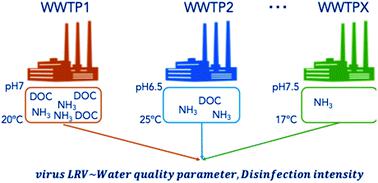当前位置:
X-MOL 学术
›
Environ. Sci.: Water Res. Technol.
›
论文详情
Our official English website, www.x-mol.net, welcomes your
feedback! (Note: you will need to create a separate account there.)
Regularized regression analysis for the prediction of virus inactivation efficiency by chloramine disinfection
Environmental Science: Water Research & Technology ( IF 3.5 ) Pub Date : 2020-10-21 , DOI: 10.1039/d0ew00539h Syun-suke Kadoya 1, 2, 3, 4, 5 , Osamu Nishimura 1, 2, 3, 4, 5 , Hiroyuki Kato 3, 4, 5, 6 , Daisuke Sano 1, 2, 3, 4, 5
Environmental Science: Water Research & Technology ( IF 3.5 ) Pub Date : 2020-10-21 , DOI: 10.1039/d0ew00539h Syun-suke Kadoya 1, 2, 3, 4, 5 , Osamu Nishimura 1, 2, 3, 4, 5 , Hiroyuki Kato 3, 4, 5, 6 , Daisuke Sano 1, 2, 3, 4, 5
Affiliation

|
Wastewater reclamation and reuse have been well-practiced in water-stressed areas, but insufficiently treated wastewater includes harmful contaminants. Sanitation safety planning employs the hazard analysis and critical control point to manage health risks due to waterborne pathogens including enteric viruses by determining the critical limit (CL) at critical control points (CCPs). At a wastewater treatment plant (WWTP), some disinfection conditions, such as initial disinfectant concentration, are available as parameters at CCPs when the log reduction value (LRV) of viruses is proportional to them. Since water quality affects disinfectant decay and varies among WWTPs, we have constructed models to predict virus LRVs in chloramine disinfection, in which operational and water quality parameters were used as model variables. Inactivation datasets of five viruses were collected using a systematic review method, and for model selection, we applied three regularized regression analyses (ridge, lasso and elastic net) to avoid multicollinearity. We found that lasso or elastic net regressions gave lower values of mean squared errors (MSEs) (smaller than 1, except for poliovirus), which indicated higher prediction performance. We then constructed models based on the hierarchical Bayesian approach, in which variables selected by lasso or elastic net regressions were applied, to take experimental errors among reports and strain-specific sensitivity to chloramine into account. The proposed modeling approach is useful for WWTP operators to determine the CL to maintain acceptable virus concentration in effluent.
中文翻译:

正则回归分析,用于通过氯胺消毒预测病毒的灭活效率
在缺水地区,废水的回收和再利用已得到很好的实践,但是处理不当的废水中会包含有害污染物。卫生安全规划采用危害分析和关键控制点,通过确定关键控制点(CCP)的关键限值(CL)来管理由水源病原体(包括肠道病毒)引起的健康风险。在废水处理厂(WWTP)中,当病毒的对数降低值(LRV)与它们成比例时,某些消毒条件(例如初始消毒剂浓度)可用作CCP的参数。由于水质会影响消毒剂的降解并在污水处理厂之间发生变化,因此我们建立了预测氯胺消毒中病毒LRV的模型,其中将运行和水质参数用作模型变量。使用系统评价方法收集了五种病毒的失活数据集,为进行模型选择,我们应用了三种正则回归分析(岭,套索和弹性网)以避免多重共线性。我们发现套索或弹性净回归的均方误差(MSE)值较低(除脊髓灰质炎病毒外,均小于1),这表明较高的预测性能。然后,我们基于分层贝叶斯方法构建模型,其中应用了套索或弹性网回归选择的变量,以考虑报告之间的实验误差以及菌株对氯胺的敏感性。拟议的建模方法对于污水处理厂运营商确定CL以维持污水中可接受的病毒浓度很有用。对于模型选择,我们应用了三个正则回归分析(岭,套索和弹性网)以避免多重共线性。我们发现套索或弹性净回归的均方误差(MSE)值较低(除脊髓灰质炎病毒外,均小于1),这表明较高的预测性能。然后,我们基于分层贝叶斯方法构建模型,其中应用了套索或弹性网回归选择的变量,以考虑报告之间的实验误差以及菌株对氯胺的敏感性。拟议的建模方法对于污水处理厂运营商确定CL以维持污水中可接受的病毒浓度很有用。对于模型选择,我们应用了三个正则回归分析(岭,套索和弹性网)以避免多重共线性。我们发现套索或弹性净回归的均方误差(MSE)值较低(除脊髓灰质炎病毒外,均小于1),这表明较高的预测性能。然后,我们基于分层贝叶斯方法构建模型,其中应用了套索或弹性网回归选择的变量,以考虑报告之间的实验误差以及菌株对氯胺的敏感性。拟议的建模方法对于污水处理厂运营商确定CL以维持污水中可接受的病毒浓度很有用。我们发现套索或弹性净回归的均方误差(MSE)值较低(除脊髓灰质炎病毒外,均小于1),这表明较高的预测性能。然后,我们基于分层贝叶斯方法构建模型,其中应用了套索或弹性网回归选择的变量,以考虑报告之间的实验误差以及菌株对氯胺的敏感性。拟议的建模方法对于污水处理厂运营商确定CL以维持污水中可接受的病毒浓度很有用。我们发现套索或弹性净回归的均方误差(MSE)值较低(除脊髓灰质炎病毒外,均小于1),这表明较高的预测性能。然后,我们基于分层贝叶斯方法构建模型,其中应用了套索或弹性网回归选择的变量,以考虑报告之间的实验误差以及菌株对氯胺的敏感性。拟议的建模方法对于污水处理厂运营商确定CL以维持污水中可接受的病毒浓度很有用。其中应用套索或弹性网回归选择的变量,以考虑报告之间的实验错误和菌株对氯胺的敏感性。拟议的建模方法对于污水处理厂运营商确定CL以维持污水中可接受的病毒浓度很有用。其中应用套索或弹性网回归选择的变量,以考虑报告之间的实验错误和菌株对氯胺的敏感性。拟议的建模方法对于污水处理厂运营商确定CL以维持污水中可接受的病毒浓度很有用。
更新日期:2020-11-03
中文翻译:

正则回归分析,用于通过氯胺消毒预测病毒的灭活效率
在缺水地区,废水的回收和再利用已得到很好的实践,但是处理不当的废水中会包含有害污染物。卫生安全规划采用危害分析和关键控制点,通过确定关键控制点(CCP)的关键限值(CL)来管理由水源病原体(包括肠道病毒)引起的健康风险。在废水处理厂(WWTP)中,当病毒的对数降低值(LRV)与它们成比例时,某些消毒条件(例如初始消毒剂浓度)可用作CCP的参数。由于水质会影响消毒剂的降解并在污水处理厂之间发生变化,因此我们建立了预测氯胺消毒中病毒LRV的模型,其中将运行和水质参数用作模型变量。使用系统评价方法收集了五种病毒的失活数据集,为进行模型选择,我们应用了三种正则回归分析(岭,套索和弹性网)以避免多重共线性。我们发现套索或弹性净回归的均方误差(MSE)值较低(除脊髓灰质炎病毒外,均小于1),这表明较高的预测性能。然后,我们基于分层贝叶斯方法构建模型,其中应用了套索或弹性网回归选择的变量,以考虑报告之间的实验误差以及菌株对氯胺的敏感性。拟议的建模方法对于污水处理厂运营商确定CL以维持污水中可接受的病毒浓度很有用。对于模型选择,我们应用了三个正则回归分析(岭,套索和弹性网)以避免多重共线性。我们发现套索或弹性净回归的均方误差(MSE)值较低(除脊髓灰质炎病毒外,均小于1),这表明较高的预测性能。然后,我们基于分层贝叶斯方法构建模型,其中应用了套索或弹性网回归选择的变量,以考虑报告之间的实验误差以及菌株对氯胺的敏感性。拟议的建模方法对于污水处理厂运营商确定CL以维持污水中可接受的病毒浓度很有用。对于模型选择,我们应用了三个正则回归分析(岭,套索和弹性网)以避免多重共线性。我们发现套索或弹性净回归的均方误差(MSE)值较低(除脊髓灰质炎病毒外,均小于1),这表明较高的预测性能。然后,我们基于分层贝叶斯方法构建模型,其中应用了套索或弹性网回归选择的变量,以考虑报告之间的实验误差以及菌株对氯胺的敏感性。拟议的建模方法对于污水处理厂运营商确定CL以维持污水中可接受的病毒浓度很有用。我们发现套索或弹性净回归的均方误差(MSE)值较低(除脊髓灰质炎病毒外,均小于1),这表明较高的预测性能。然后,我们基于分层贝叶斯方法构建模型,其中应用了套索或弹性网回归选择的变量,以考虑报告之间的实验误差以及菌株对氯胺的敏感性。拟议的建模方法对于污水处理厂运营商确定CL以维持污水中可接受的病毒浓度很有用。我们发现套索或弹性净回归的均方误差(MSE)值较低(除脊髓灰质炎病毒外,均小于1),这表明较高的预测性能。然后,我们基于分层贝叶斯方法构建模型,其中应用了套索或弹性网回归选择的变量,以考虑报告之间的实验误差以及菌株对氯胺的敏感性。拟议的建模方法对于污水处理厂运营商确定CL以维持污水中可接受的病毒浓度很有用。其中应用套索或弹性网回归选择的变量,以考虑报告之间的实验错误和菌株对氯胺的敏感性。拟议的建模方法对于污水处理厂运营商确定CL以维持污水中可接受的病毒浓度很有用。其中应用套索或弹性网回归选择的变量,以考虑报告之间的实验错误和菌株对氯胺的敏感性。拟议的建模方法对于污水处理厂运营商确定CL以维持污水中可接受的病毒浓度很有用。









































 京公网安备 11010802027423号
京公网安备 11010802027423号